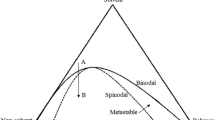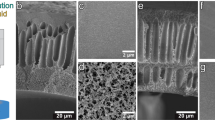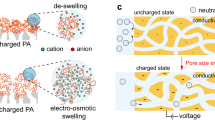Abstract
An attempt was made to investigate the process of forming porous polymeric membrane by computer simulation experiments based on Monte Carlo method. In this approach secondary particles (i.e., polymer-rich phase; referred to as polymer particles) and vacant particles (i.e., polymer-lean phase) are assumed to have the same radius S2 and the number ratio of those particles is predetermined by two-phase volume ratio R (≡V(1)/V(2); V(1) and V(2) are volumes of polymer-lean and -rich phases, respectively). These particles are arranged randomly on a hypothetical hexagonally closest packing lattice plane and all pores consisting of x vacant particles, which are referred to as “vacant particle pores,” are counted one by one to give probability of appearance of NP Vacant-particle pores in unit area of membrane, Q(NP), from which expected value of NP, {NP} are determined. Probability P(x) that a given pore contains x vacant particles and the average of number of vacant particles in one pore, x are also determined. In the range of R≤0.4, the theory on pore size distribution, proposed by Iijima, Matsuda, and Kamide in a previous paper, gives the same curves of P(x), NP, and x (accordingly, number-average pore radius of wet membrane, {rWet,1}) as those by the simulation, meaning that the theory holds its validity with respect to pore size distribution N(r) (r, radius of pore) and NP. Morphology and P(x) of the piled plane are shown to be practically the same as those of a hypothetical thin plane directly formed at an apparent phase volume ratio RA, evaluated from the number ratio of polymer particles and vacant particles on the surface of the piled plane by taking into consideration of overlapping. It is ascertained that computer experiments can produce membranes with morphology very similar to actual membranes and we can evaluate, by computer simulation, accurately the morphology and pore size distribution using RA, in place of R.
Similar content being viewed by others
Log in or create a free account to read this content
Gain free access to this article, as well as selected content from this journal and more on nature.com
or
References
K. Kamide, H. Iijima, and S. Matsuda, Polym. J., 25, 1113 (1993).
K. Kamide, H. Iijima, and H. Shirataki, Polym. J., 26, 21 (1994).
H. Iijima, S. Matsuda, and K. Kamide, Polym. J., 26, 439 (1994).
K. Kamide and S. Manabe, in “Ultrafiltration Membranes and Applications,” Polymer Science and Technology, Vol. 13, A. R. Cooper, Ed., Plenum Press, New York, N. Y., 1980, pp 173—202.
S. Manabe, Y. Shigemoto, and K. Kamide, Polym. J., 17, 775 (1985).
K. Kamide and S. Manabe, in “Material Science of Synthetic Membranes,” D. R. Lloyd, Ed., ACS Symposium Series No. 269, American Chemical Society, Washington, D. C., 1985, pp 197—228.
Author information
Authors and Affiliations
Rights and permissions
About this article
Cite this article
Kamide, K., Iijima, H. & Kataoka, A. Thermodynamics of Formation of Porous Polymeric Membrane by Phase Separation Method IV. Pore Formation by Contacting Secondary Particles: Computer Simulation Experiments. Polym J 26, 623–636 (1994). https://doi.org/10.1295/polymj.26.623
Issue date:
DOI: https://doi.org/10.1295/polymj.26.623



